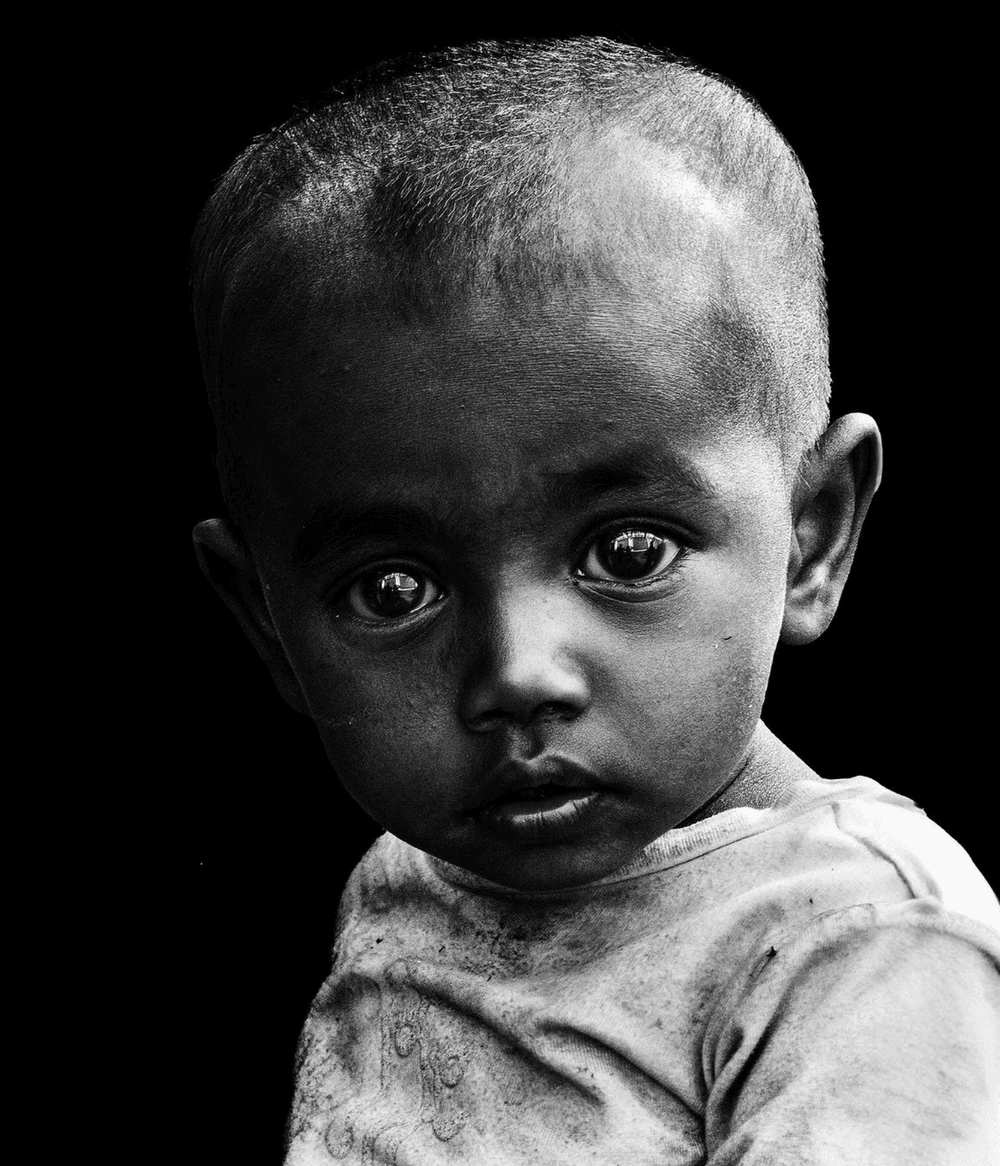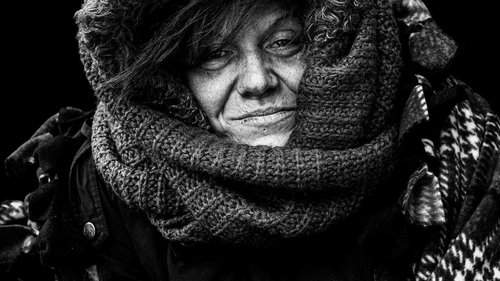Stay in the Loop
BSR publishes on a weekly schedule, with an email newsletter every Wednesday and Thursday morning. There’s no paywall, and subscribing is always free.
Facing homelessness
The Mütter Museum presents Unhoused: Personal Stories and Public Health

These are the faces we pretend not to see, crouched on sidewalks and begging on median strips. Unlike most of us, Leah den Bok and Willie Baronet don’t turn away, and in Unhoused: Personal Stories and Public Health, the Mütter Museum uses what they’ve seen to depict the toll of homelessness.
Den Bok has been photographing unhoused people for almost half of her 23 years. Her connection is personal: at age three, her mother, Sara den Bok, was abandoned on the streets of Kolkata, India. Police brought her to an orphanage operated by Saint Mother Teresa, from which she was later adopted.
In 2014, the Toronto-based photographer and her father, Tim den Bok, began traveling across North America to talk with unhoused people. Leah makes the images, Tim takes notes, and both converse with the person, asking the sort of questions people ask when getting acquainted. Approaching someone, they ask permission to photograph and interview and pay those who agree $10. One man, Nathan, 68, was worried that the money was counterfeit, so Tim exchanged it for him. Despite having a mother and sister who lived locally, Nathan told the den Boks he kept to himself. He looks to one side, face half in shadow and mouth slightly open, as though wanting to say something.
Human beings, not circumstances
“They just want someone to see them as human beings,” Leah has said, a sentiment echoed by those living on Philadelphia’s streets. “We’re human and we’re not bad people because we’re out here. We’re just less fortunate,” reads one of several local quotes posted in Unhoused. “I wish people would be more, like, you know, understanding and not so mean about it. You know, I don’t want to be here.”
The emotional impact of the exhibit is grounded in findings from Even a Smile Helps, a 2021 research project led by Rosemary Frasso of Thomas Jefferson University, a fellow of the College of Physicians of Philadelphia. (The Mütter is the college’s medical history museum.) Frasso and René Najera, the college’s public health chairperson, provide research confirming that homelessness is just one of several interrelated crises fed by poor public policy. The exhibit summarizes how policy has exacerbated and could improve homelessness, the availability and affordability of health care, mental health and addiction treatment, and poverty.
Homelessness by the numbers
Counting unhoused people is notoriously difficult. The point-in-time method, a simultaneous count across an area, is the standard used to obtain comparative figures. According to the US Department of Housing and Human Services, in January 2023, there were 653,104 unhoused persons in the US, 4,725 of them in Philadelphia. According to Philadelphia’s Project HOME, that figure represented a 5.2 percent increase in the city over 2022.

Philadelphia’s root problem is pervasive poverty. The exhibit indicates that for every 10,000 city residents, about 30 are unhoused. Project HOME estimates that in 2022, about 8,206 people, including families, accessed emergency shelters in Philadelphia; many more were turned away for lack of capacity. HHS indicates that on any given night in America, there are shelter beds available for less than 38 percent of those in need.
Penetrating looks
Leah’s exploration has become a project, Humanizing the Homeless, which has taken the family to many countries and produced multiple volumes of Nowhere to Call Home: Photographs and Stories of the Homeless. All profits support shelters in areas the den Boks visit.
Visitors to the Mütter are confronted by a collage of unnervingly penetrating stares. Booklets provide stories for each of the 40 faces, aged two to 80. “It’s as if you could see their whole story just by looking into their eyes,” says Leah. If only we would.
Gisell’s piercing eyes caught Tim’s attention in Toronto. Addiction had kept her from her three children for seven years, and she worried what her drug abuse and absence had done to them. She wanted to visit (they are with their father) but wanted to clean up first. Gisell gazes painfully into the lens, holding a grimy hand to her mouth as if blowing a kiss to her children.
Traveling in Kolkata, Leah photographed Bari, age two, whose father abandoned her, her four brothers, and their mother. The family begs and sleeps in a slum with other unhoused people. Looking into Bari’s huge eyes, Leah thought of malnutrition.
Signs of humanity
Initially, Baronet reacted like most people: “I avoided eye contact with those on the street, unwilling to really see them, and in doing so avoided parts of myself,” he said. “That began to change once I began asking them if they would sell their signs. … The conversations and connections have left an indelible mark on my heart.”
Baronet, an artist and professor of creative advertising at Dallas’s Southern Methodist University, has purchased 1,800 signs since 1993. From them, he creates evocative installations in an ongoing project, We Are All Homeless. Baronet’s 2014 cross-country journey to 24 cities is portrayed in an award-winning documentary, Signs of Humanity.

A legion of voices speak from the neat assemblage of cardboard squares as if in conversation with the portraits at the other end of the gallery. Displayed as a group away from the distractions of the street, the signs take on a dignified power and make a statement that will not be ignored.
Some are philosophical. God is mentioned often. One is unexpectedly funny: “Buy an authentic one of a kind NYC homeless persons sign! (Homeless guy sold separately).”
Those with the fewest words go straight to the heart, like “Need $14 to go to Brothers funeral Please,” “Hard Times, God still loves me…can you?,” “Not my proudest moment Never thought this could happen Anything helps God bless,” or “Please pray for me Simply hungry God bless.”
Think, look, start
Cork boards invite visitors to reply to three questions: what home means, if they’ve experienced homelessness, and what they could do to address the problem. Blue sticky notes are provided as if answers to such questions could be distilled onto tiny squares any more than troubled lives can be summarized on the side of a box. But the exercise is worthwhile if it makes us think, do something, or even just look. That’s a start.
At top: Leah den Bok’s Bari. (Courtesy of the Mütter Museum.)
What, When, Where
Unhoused: Personal Stories and Public Health. Through August 5, 2024, at the Mütter Museum Historical Medical Library, 19 S 22nd Street, Philadelphia. (215) 563-3737 or muttermuseum.org.
Accessibility
Mütter Museum has a wheelchair-accessible entrance on Van Pelt Street directly behind the museum; visitors can request assistance by using the intercom. Wheelchair-accessible restrooms are located on the second floor; visitor services associates can provide elevator access. Unhoused is located on the museum’s first floor. More information is available at the Mütter’s accessibility page.
Sign up for our newsletter
All of the week's new articles, all in one place. Sign up for the free weekly BSR newsletters, and don't miss a conversation.
